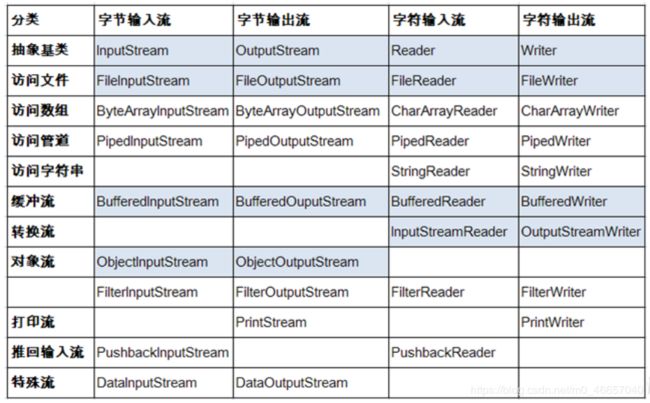JAVA第十课 流
第十课
- 流
- File类
- 流的分类
- 流的体系
- 字符流读写
- 字节流读写
- 处理流之一:缓冲流的使用
- 转换流
- Object流
流
File类
- 路径分隔符和系统有关:
- windows和DOS系统默认使用“\”来表示
- UNIX和URL使用“/”来表示
- public static final String separator。根据操作系统,动态的提供分隔符。
File file1 = new File("d:\\atguigu\\info.txt");
File file2 = new File("d:" + File.separator +"atguigu"+ File.separator + "info.txt");
File file3 = new File("d:/atguigu");- File类的获取功能
public String getAbsolutePath():获取绝对路径
public String getPath() :获取路径
public String getName() :获取名称
public String getParent():获取上层文件目录路径。若无,返回null
public long length() :获取文件长度(即:字节数)。不能获取目录的长度。
public long lastModified() :获取最后一次的修改时间,毫秒值
public String[] list() :获取指定目录下的所有文件或者文件目录的名称数组
public File[] listFiles() :获取指定目录下的所有文件或者文件目录的File数组- file类的重命名功能
public boolean renameTo(File dest):把文件重命名为指定的文件路径- File类的判断功能
public boolean isDirectory():判断是否是文件目录
public boolean isFile() :判断是否是文件
public boolean exists() :判断是否存在
public boolean canRead() :判断是否可读
public boolean canWrite() :判断是否可写
public boolean isHidden() :判断是否隐藏- File类的创建功能
public boolean createNewFile() :创建文件。若文件存在,则不创建,返回false
public boolean mkdir() :创建文件目录。如果此文件目录存在,就不创建了。
如果此文件目录的上层目录不存在,也不创建。
public boolean mkdirs() :创建文件目录。如果上层文件目录不存在,一并创建
注意事项:如果你创建文件或者文件目录没有写盘符路径,那么,默认在项目路径下。
- File类的删除功能
public boolean delete():删除文件或者文件夹删除注意事项:Java中的删除不走回收站。 要删除一个文件目录,请注意该文件目录内不能包含文件或者文件目录
流的分类
- 按操作数据单位不同分为:字节流(8 bit),字符流(16 bit)
- 按数据流的流向不同分为:输入流,输出流
- 按流的角色的不同分为:节点流,处理流
| (抽象基类) | 字节流 | 字符流 |
|---|---|---|
| 输入流 | InputStream | Reader |
| 输出流 | OutputStream | Writer |
流的体系
字符流读写
字符流适合对文本文件进行读写但是能读写图像或视频
@Test
public void testFileReaderFileWriter() {
FileReader fr = null;
FileWriter fw = null;
try {
//1.创建File类的对象,指明读入和写出的文件
File srcFile = new File("hello.txt");
File destFile = new File("hello2.txt");
//不能使用字符流来处理图片等字节数据
// File srcFile = new File("爱情与友情.jpg");
// File destFile = new File("爱情与友情1.jpg");
//2.创建输入流和输出流的对象
fr = new FileReader(srcFile);
fw = new FileWriter(destFile);
//3.数据的读入和写出操作
char[] cbuf = new char[5];
int len;//记录每次读入到cbuf数组中的字符的个数
while((len = fr.read(cbuf)) != -1){
//每次写出len个字符
fw.write(cbuf,0,len);
}
} catch (IOException e) {
e.printStackTrace();
} finally {
//4.关闭流资源
//方式一:
// try {
// if(fw != null)
// fw.close();
// } catch (IOException e) {
// e.printStackTrace();
// }finally{
// try {
// if(fr != null)
// fr.close();
// } catch (IOException e) {
// e.printStackTrace();
// }
// }
//方式二:
try {
if(fw != null)
fw.close();
} catch (IOException e) {
e.printStackTrace();
}
try {
if(fr != null)
fr.close();
} catch (IOException e) {
e.printStackTrace();
}
}
}字节流读写
字节流适合图像或视频的读取,如果要输出在控制台就不适合文本文件的读写(因为可能出现乱码),如果只进行复制可以使用。
/*
实现对图片的复制操作
*/
@Test
public void testFileInputOutputStream() {
FileInputStream fis = null;
FileOutputStream fos = null;
try {
//
File srcFile = new File("爱情与友情.jpg");
File destFile = new File("爱情与友情2.jpg");
//
fis = new FileInputStream(srcFile);
fos = new FileOutputStream(destFile);
//复制的过程
byte[] buffer = new byte[5];
int len;
while((len = fis.read(buffer)) != -1){
fos.write(buffer,0,len);
}
} catch (IOException e) {
e.printStackTrace();
} finally {
if(fos != null){
//
try {
fos.close();
} catch (IOException e) {
e.printStackTrace();
}
}
if(fis != null){
try {
fis.close();
} catch (IOException e) {
e.printStackTrace();
}
}
}
}处理流之一:缓冲流的使用
- 缓冲流:
- BufferedInputStream
- BufferedOutputStream
- BufferedReader
- BufferedWriter
-
作用:提供流的读取、写入的速度
提高读写速度的原因:内部提供了一个缓冲区 -
处理流,就是“套接”在已有的流的基础上。
实现非文本文件的复制
public class BufferedTest {
@Test
public void BufferedStreamTest() {
BufferedInputStream bis = null;
BufferedOutputStream bos = null;
try {
//1.造文件
File srcFile = new File("爱情与友情.jpg");
File destFile = new File("爱情与友情3.jpg");
//2.造流
//2.1 造节点流
FileInputStream fis = new FileInputStream((srcFile));
FileOutputStream fos = new FileOutputStream(destFile);
//2.2 造缓冲流
bis = new BufferedInputStream(fis);
bos = new BufferedOutputStream(fos);
//3.复制的细节:读取、写入
byte[] buffer = new byte[10];
int len;
while((len = bis.read(buffer)) != -1){
bos.write(buffer,0,len);
// bos.flush();//刷新缓冲区
}
} catch (IOException e) {
e.printStackTrace();
} finally {
//4.资源关闭
//要求:先关闭外层的流,再关闭内层的流
if(bos != null){
try {
bos.close();
} catch (IOException e) {
e.printStackTrace();
}
}
if(bis != null){
try {
bis.close();
} catch (IOException e) {
e.printStackTrace();
}
}
//说明:关闭外层流的同时,内层流也会自动的进行关闭。关于内层流的关闭,我们可以省略.
// fos.close();
// fis.close();
}
}使用BufferedReader和BufferedWriter实现文本文件的复制
@Test
public void testBufferedReaderBufferedWriter(){
BufferedReader br = null;
BufferedWriter bw = null;
try {
//创建文件和相应的流
//嵌套写法
br = new BufferedReader(new FileReader(new File("dbcp.txt")));
bw = new BufferedWriter(new FileWriter(new File("dbcp1.txt")));
//读写操作
//方式一:使用char[]数组
// char[] cbuf = new char[1024];
// int len;
// while((len = br.read(cbuf)) != -1){
// bw.write(cbuf,0,len);
// bw.flush();
// }
//方式二:使用String
String data;
while((data = br.readLine()) != null){
//方法一:
// bw.write(data + "\n");//data中不包含换行符
//方法二:
bw.write(data);//data中不包含换行符
bw.newLine();//提供换行的操作
}
} catch (IOException e) {
e.printStackTrace();
} finally {
//关闭资源
if(bw != null){
try {
bw.close();
} catch (IOException e) {
e.printStackTrace();
}
}
if(br != null){
try {
br.close();
} catch (IOException e) {
e.printStackTrace();
}
}
}
}转换流
- 转换流提供了在字节流和字符流之间的转换
Java API提供了两个转换流:
- InputStreamReader:将InputStream转换为Reader
- OutputStreamWriter:将Writer转换为OutputStream
@Test
public void testInputStreamReaderOutputStreamWriter() {
InputStreamReader isr=null;
OutputStreamWriter osw=null;
try {
//1.造文件、造流
File file1 = new File("dbcp.txt");
File file2 = new File("dbcp_gbk.txt");
FileInputStream fis = null;
fis = new FileInputStream(file1);
FileOutputStream fos = new FileOutputStream(file2);
isr = new InputStreamReader(fis, "utf-8");
osw = new OutputStreamWriter(fos, "gbk");
//2.读写过程
char[] cbuf = new char[20];
int len;
while ((len = isr.read(cbuf)) != -1) {
osw.write(cbuf, 0, len);
}
} catch (IOException e) {
e.printStackTrace();
} finally {
//3.关闭资源
try {
isr.close();
} catch (IOException e) {
e.printStackTrace();
}
try {
osw.close();
} catch (IOException e) {
e.printStackTrace();
}
}
}Object流
- ObjectInputStream和OjbectOutputSteam
- 用于存储和读取基本数据类型数据或对象的处理流。它的强大之处就是可
以把Java中的对象写入到数据源中,也能把对象从数据源中还原回来。
- 序列化:用ObjectOutputStream类保存基本类型数据或对象的机制
- 反序列化:用ObjectInputStream类读取基本类型数据或对象的机制
- ObjectOutputStream和ObjectInputStream不能序列化static和transient修
饰的成员变量 - 对象序列化机制允许把内存中的Java对象转换成平台无关的二进制流,从
而允许把这种二进制流持久地保存在磁盘上,或通过网络将这种二进制流传
输到另一个网络节点。//当其它程序获取了这种二进制流,就可以恢复成原
来的Java对象 - 序列化的好处在于可将任何实现了Serializable接口的对象转化为字节数据,
使其在保存和传输时可被还原 - 凡是实现Serializable接口的类都有一个表示序列化版本标识符的静态变量:
- private static final long serialVersionUID;
- serialVersionUID用来表明类的不同版本间的兼容性。简言之,其目的是以序列化对象
进行版本控制,有关各版本反序列化时是否兼容。
- 如果类没有显示定义这个静态常量,它的值是Java运行时环境根据类的内部细节自
动生成的。若类的实例变量做了修改,serialVersionUID 可能发生变化。故建议,
显式声明。
序列化
1.创建一个 ObjectOutputStream
2.调用 ObjectOutputStream 对象的 writeObject(对象) 方法输出可序列化对象
3.注意写出一次,操作flush()一次
4.close()
反序列化
1. 创建一个 ObjectInputStream
2. 调用 readObject() 方法读取流中的对象
强调:如果某个类的属性不是基本数据类型或 String 类型,而是另一个引用类型,那么这个引用类型必须是可序列化的,否则拥有该类型的Field 的类也不能序列化
3. close()
//序列化:将对象写入到磁盘或者进行网络传输。
//要求对象必须实现序列化
ObjectOutputStream oos = new ObjectOutputStream(new FileOutputStream(“data.txt"));
Person p = new Person("韩梅梅", 18, "中华大街", new Pet());
oos.writeObject(p);
oos.flush();
oos.close();
//反序列化:将磁盘中的对象数据源读出。
ObjectInputStream ois = new ObjectInputStream(new FileInputStream(“data.txt"));
Person p1 = (Person)ois.readObject();
System.out.println(p1.toString());
ois.close();

